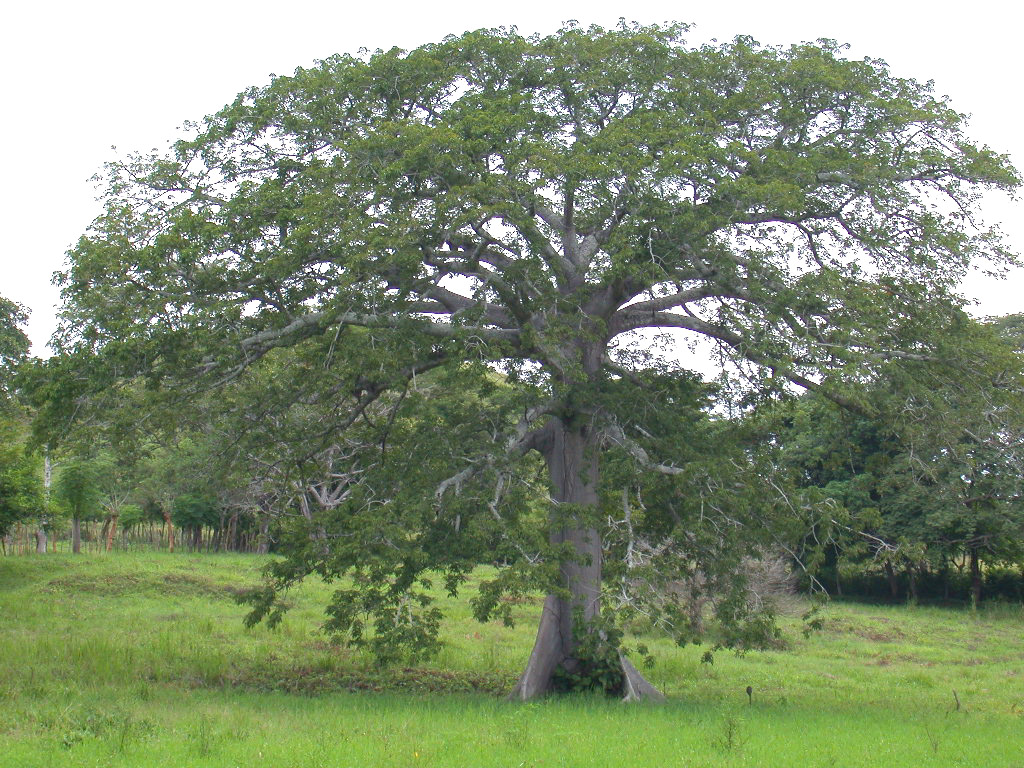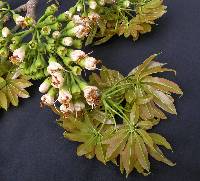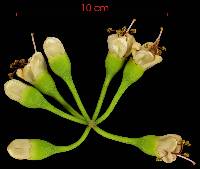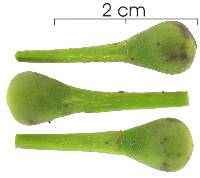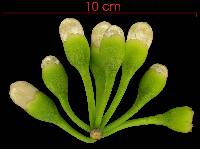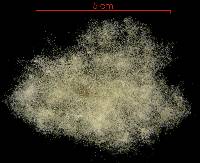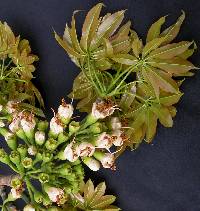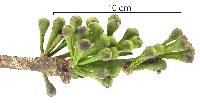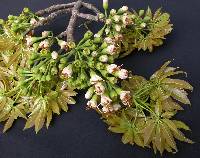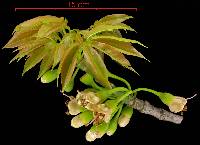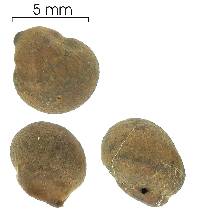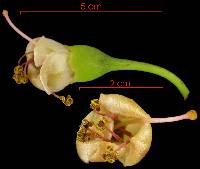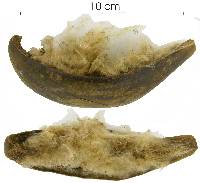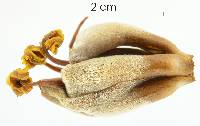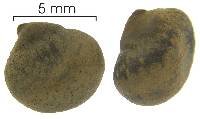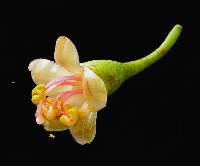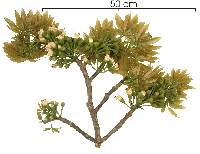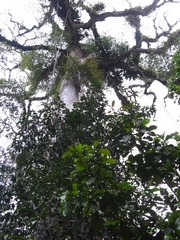

|
|
|
|
Family: Bombacaceae
Kapoktree, more... (es: ceiba, Bonga, ceibo, kapok)
|
Description: One of the giant trees of the area, with spectacular, immense plank buttresses. In larger trees, the trunk is very straight and cylindrical, having gray bark with dark, vertical fissures. There is generally one set of horizontal branches at the top - the trunk ends where it branches; the branches can be enormous, over 1 m in diameter. The crown is large, and Ceiba is perhaps one of the widest-crowned trees in the world (some may reach 40 m in crown width), but has rather thin foliage. The leaves are palmately compound, with 5 narrow, pointed leaflets arranged radially. Saplings have sharp spines all over the trunk. Reproduction: The annual cycle varies from year to year in the area. In some years, all leaves fall in December, but readily regrow, and no flowers are produced. In other years (or in other trees), leaves fall and flowers and produced in December, and trees remain leafless for several months while fruits develop. Flowers are yellowish, fruits are green pods with many tiny seeds. The seeds are surrounded by cotton-like fuzz, so they float in the wind. Distribution: Widespread but never common, there are occasional giant trees in mature forest at Barro Colorado, Soberania, and along the Caribbean coast. There are also occasional trees near Panama City and along roads throughout the area. Seldom seen as a juvenile. Similar Species: Large trees should be unmistakable, since other species with large buttresses LK (ficuin Ficus insipida LK2 or LK sterap Sterculia apetala) LK2 do no have such fat, straight, trunks, with gray, fissured bark. Other Bombacaceae have leaves like Ceiba LK (pse1se Pseudobombax septenatum LK2 and the genus LK pochqu Pachira). LK2 The latter have buttresses, but yellowish bark unlike Ceiba's. As juveniles, the various Bombacaceae can be confused, but only Ceiba and Pachira quinata have spines. A very rare species in the area, LK jac2sp Jacaratia spinosa, LK2 has spines and palmate leaves like Ceiba. As adults, Jacaratia has no buttresses; it could be confused with Ceiba as a juvenile, but neither species is seen often as a juvenile. Uses: The filaments around the seeds were once used as kapok for life-preservers and pillows. The wood is light and soft. Seeds have oil, and are eaten ground or roasted, or used for making so Descripción: Árbol de 20 a 50 m de alto. Copa amplia y con ramas verticiladas muy gruesas. Ramitas terminales con savia mucilaginosa. Tronco con raíces tablares grandes en la base, a veces con espinas. En árboles jóvenes el tronco tiene espinas cónicas y líneas verticales de color verde. Hojas digitadas y alternas. Folíolos 5-9, de 10-21 x 2-4 cm, lanceolados, con ápice acuminado, bordes enteros o dentados y base obtusa o aguda. Estípulas deciduas. Pecíolo de 5-23 cm de largo. Flores blancas, cremas o ligeramente rosadas, aromáticas. Frutos en cápsulas elipsoidales, de 10-26 cm de largo, dehiscentes en cinco valvas al madurar. Semillas envueltas por una capa de pelos algodonosos. Datos Ecológicos: La especie crece a bajas elevaciones, en bosques secos, húmedos o muy húmedos. En Panamá se encuentra en las provincias de Bocas del Toro, Chiriquí, Colón, Darién, Herrera, Los Santos, Panamá y Veraguas. Común y fácil de observar en bosques con suelos aluvionales cercanos al curso de los ríos y los riachuelos. Deja caer sus hojas alrededor de noviembre y febrero, pero las repone rápidamente. Florece y fructifica de noviembre a marzo. Las flores son visitadas por abejas, aves, murciélagos, zarigüeyas y otros mamíferos. Especies Parecidas: A menudo se confunde con LK jac2sp Jacaratia spinosa LK2 , pero J. spinosa tiene savia lechosa, lo cual no ocurre en Ceiba. También se puede confundir con plantas juveniles de LK pochqu Pachira quinata LK2 , pero en P. quinata el tronco es de color marrón y las espinas tienen las puntas arqueadas, en C. pentandra el tronco tiene líneas verticales verdes y las espinas no presentan las puntas arqueadas. Usos: La madera es empleada para producir pulpa de celulosa, en el contrachapado, embalaje, cielo raso y en la elaboración de cajas. Los pelos algodonosos del fruto se usan para fabricar salvavidas, colchones y como aislante térmico. Las semillas son ricas en aceites y se comen asadas o molidas, también se utilizan para fabricar jabones y margarinas. La corteza, hojas y tallos tiernos se emplean en la medicina popular. En fincas dedicadas a la apicultura el árbol es clasificado como planta melífera de gran valor. Silkcotton tree, Ceiba, Cotton tree, Bongo Tree, to 40 m tall; trunk ca 1.5 (2.5) m dbh, armed at least when young, with large, curving plank buttresses to 10 m high and 10 m wide at base; outer bark grayish-brown with horizontal lenticular lines. Leaves clustered at tips of branchlets, palmately compound, glabrous; stipules ovate, to 6 mm long, caducous; petioles 5-23 cm long; leaflets 5-9, oblong-lanceolate, acuminate, narrowed and obtuse to acute at base, 10-21 cm long, 2-4.5 cm wide, +/- entire. Flowers precocious, in clusters at tips of branchlets, ca 3 cm long; pedicels ca 2.5 cm long; calyx bell-shaped, ca 1 cm long and wide, with 4 or 5 small lobes, glabrous, drying dark; petals 5, oblong, ca 3 cm long and 1 cm wide, light yellow; stamens 5, united at base into a column; anthers 2 or 3 per stamen, linear, 1-celled, spiraled; style slightly surpassing stamens, surmounted by a capitate stigma. Capsules elongate-elliptic to obovoid, 10-26 cm long, to 4 cm diam, the valves 5, greenish, opening to expose copious grayish kapok and seeds; seeds numerous, round, ca 5 mm long. Croat 14071. Frequent in the forest. Flowering usually from December through February, but individuals never flower 2 years in succession and sometimes only once in 5 years. Mature fruits are seen from January to March. Allen (1956) reported flowers in Costa Rica in February, with the fruits maturing in late March. Leaves fall in the late rainy season to the early dry season. In reproductive years individuals may be leafless much longer than during sterile years (R. Foster, pers. comm.). In open areas the crown of the tree may be wider than the tree is tall. See fig. on p. 10. Bocas Species Database Characteristics: Tree that reaches from 20 to 50 m in height. The top of the tree has thick branches and the base roots occasionally are covered in spines. Flowers are white, beige or slightly pink in color. |
|
|
|

